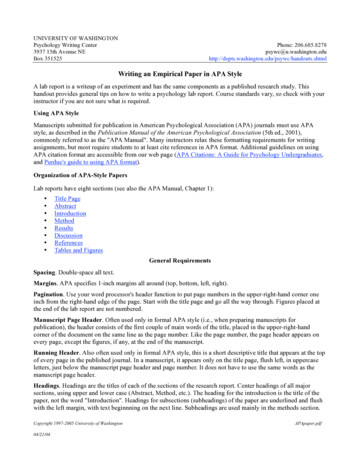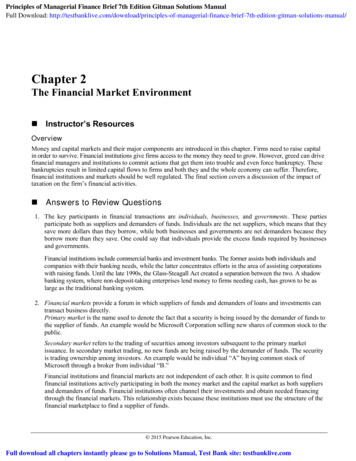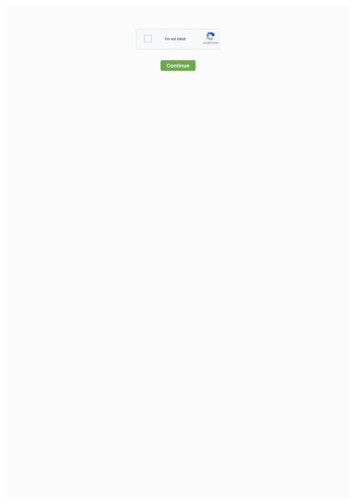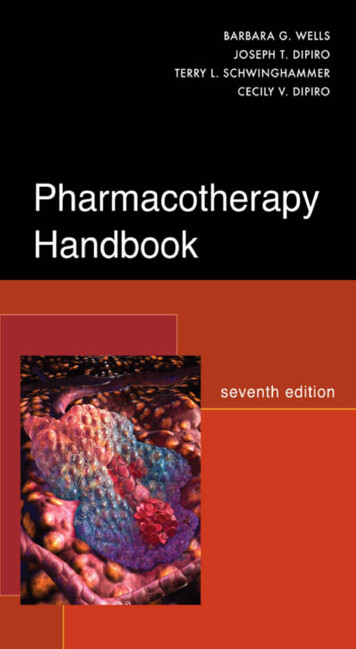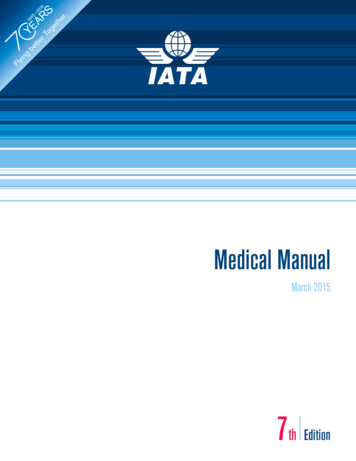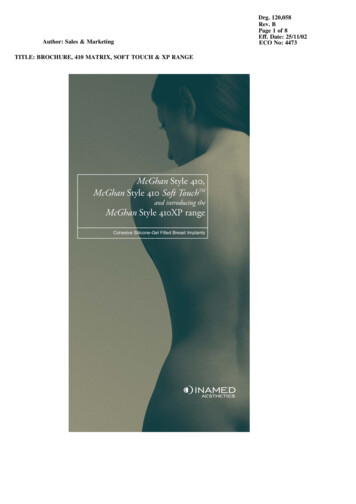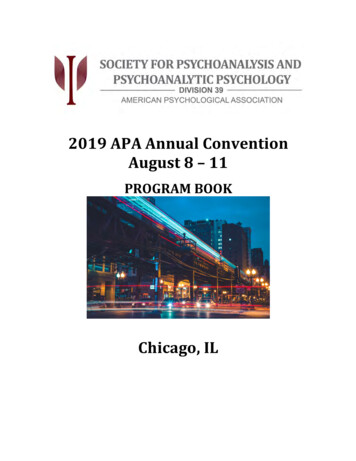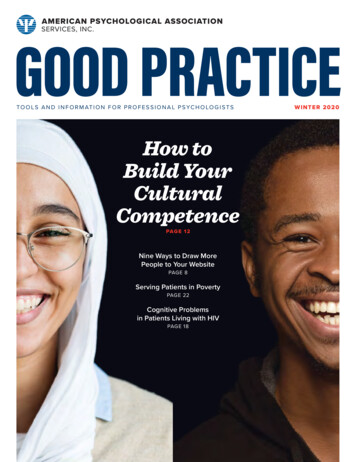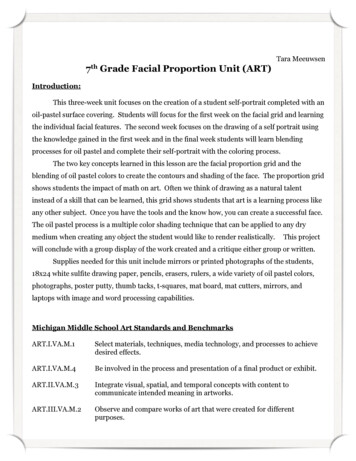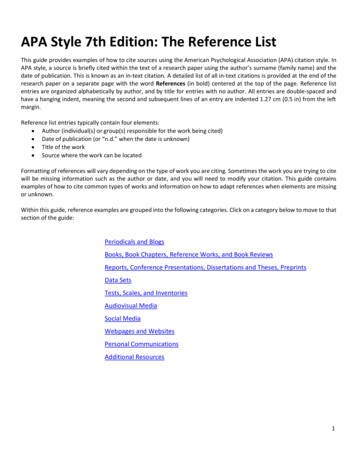
Transcription
APA Style 7th Edition: The Reference ListThis guide provides examples of how to cite sources using the American Psychological Association (APA) citation style. InAPA style, a source is briefly cited within the text of a research paper using the author’s surname (family name) and thedate of publication. This is known as an in-text citation. A detailed list of all in-text citations is provided at the end of theresearch paper on a separate page with the word References (in bold) centered at the top of the page. Reference listentries are organized alphabetically by author, and by title for entries with no author. All entries are double-spaced andhave a hanging indent, meaning the second and subsequent lines of an entry are indented 1.27 cm (0.5 in) from the leftmargin.Reference list entries typically contain four elements: Author (individual(s) or group(s) responsible for the work being cited) Date of publication (or “n.d.” when the date is unknown) Title of the work Source where the work can be locatedFormatting of references will vary depending on the type of work you are citing. Sometimes the work you are trying to citewill be missing information such as the author or date, and you will need to modify your citation. This guide containsexamples of how to cite common types of works and information on how to adapt references when elements are missingor unknown.Within this guide, reference examples are grouped into the following categories. Click on a category below to move to thatsection of the guide:Periodicals and BlogsBooks, Book Chapters, Reference Works, and Book ReviewsReports, Conference Presentations, Dissertations and Theses, PreprintsData SetsTests, Scales, and InventoriesAudiovisual MediaSocial MediaWebpages and WebsitesPersonal CommunicationsAdditional Resources1
Periodicals and BlogsGeneral format for articles from periodicals (e.g., journals, magazines, newspapers, blogs):Author name(s). (publication date). Title of article. Title of Periodical, volume number, (issue number), pages. DOI or URL The format of the various parts of the reference may vary depending on the type of periodical you are citing.When information in the source is missing or unknown (e.g., volume numbers, issue numbers, pages), omit themfrom the reference.The following examples illustrate how to cite common types of periodicals. Please refer to the Publication Manual of theAmerican Psychological Association, 7th ed., (pp. 316-321) for more information and examples.Journal article with a DOI:Roulin, N., & Krings, F. (2020). Faking to fit in: Applicants’ response strategies to match organizational culture.Journal of Applied Psychology, 105(2), 130–145. https://doi.org/10.1037/apl0000431DOIs and URLs: A DOI (Digital Object Identifier) provides a stable and persistent link to an article, book, or other document on theinternet. Include a DOI for all works that have a DOI. The preferred format for a DOI is to display it as a hyperlink beginning with https://doi.org/ followed by the DOInumber as shown in the example above. All DOIs in your reference list should be formatted this way. If a DOI in a work you are citing follows a different format, edit the DOI so that it reflects the preferred format. Both DOIs and URLs can be displayed as plain text (no underlining) or with underlining (e.g., the default setting forhyperlinks in most word-processors). Both are acceptable, but choose one format and be consistent throughout yourreference list. Do not add a period at the end of a DOI/URL or manually insert a line break. Line breaks that are automaticallyinserted by your word-processor are acceptable.Journal article without a DOI, with a nondatabase URL:Woods, A. D., Taylor, M., & Dumas, B. (2019). Social media usage by millennial college students: Thedevelopment of the digital-age student leader. Academy of Educational Leadership Journal, 23(1), 3-23-1-128.pdf For online articles that do not have a DOI, but do have a URL, include the URL in the Reference. URLs should link directly to the article when possible. For articles retrieved from academic research databases that do not have a DOI, refer to the next example.2
Journal article without a DOI, from most academic research databases or print version:Jain, L., & Ansari, A. A. (2018). Effect of perception of organisational politics on employee engagement withpersonality traits as moderating factors. The South East Asian Journal of Management, 12(1), 85–104. Do not include the database name or URL for most academic research databases. If an article does not contain a DOI,format the citation as if you were citing the print version of the article.Some exceptions may apply, for example, the database name is included in the reference if the work you are citingcan only be retrieved from that particular database. Please refer to Chapter 10, examples 13 & 14, p. 319 of thePublication Manual of the American Psychological Association, 7th ed. for more information.Journal article with a DOI, multiple authors:Curry, O. S., Rowland, L. A., Van Lissa, C. J., Zlotowitz, S., McAlaney, J., & Whitehouse, H. (2018). Happy to help?A systematic review and meta-analysis of the effects of performing acts of kindness on the well-being ofthe actor. Journal of Experimental Social Psychology, 76, 320–329. For articles with two to 20 authors, include all authors (surname followed by initials). Insert an ampersand (&)before the final author. For articles with 21 or more authors, include the first 19 authors, followed by an ellipsis (. . .),and then the final author (see Chapter 10, example 4, p. 317 of the Publication Manual of the American PsychologicalAssociation, 7th ed.).Journal article with an article number or eLocator:Xie, Z., & Zhou, S. (2020). Bilingualism, demographics, and cognitive control: A within-group approach. Frontiersin Psychology, 11, Article 94. https://doi.org/10.3389/fpsyg.2020.00094 If an article has an article number or eLocator (e.g., e0206266), include it in the citation instead of page numbers.Precede the number with the word Article (capitalized).Magazine article with a DOI:Xu, L. (2018, November). Exploiting psychology and social behavior for game stickiness. Communications of theACM, 61(11), 52–53. https://doi.org/10.1145/3239544Magazine or newspaper article without a DOI, with a nondatabase URL:Gallo, A. (2015, February 4). How to build a meaningful career. Harvard Business ingful-career3
Martin, J. (2019, October 3). Small businesses caught in an ‘epidemic’ of cyber attacks. The Globe and -ofcyber-attacks/Magazine or newspaper article without a DOI, from most academic research databases or print version:Coy, P. (2018, October 29). Companies give worker training another try. Bloomberg Businessweek, 4590, 36–37.Kennedy, P. (2019, March 17). The new science of cuteness. The New York Times, 68(58269), 1–5. Do not include the database name or URL for most academic research databases. If an article does not contain a DOI,format the citation as if you were citing the print version of the article.Blog post:Bennett, K. (2020, March 31). Facebook friends: The real deal or social mirage? Psychology ocial-mirageBooks, Book Chapters, Reference Works, and Book ReviewsGeneral format for books, book chapters and entries in reference works:Author(s) or Editor(s). (Year of publication). Title of book (additional information if applicable, e.g. edition,volume, etc.). Publisher Name. DOI or URLAuthor(s) of chapter or entry. (Year of publication). Title of chapter or entry. Editor(s), Title of book (additionalinformation if applicable, e.g. edition, volume, page numbers). Publisher Name. DOI or URLThe following examples illustrate how to cite common types of book sources. Please refer to the Publication Manual ofthe American Psychological Association, 7th ed., (pp. 321-329 & pp. 334-335) for more information and examples.Authored book with a DOI:Ladge, J. J., & Greenberg, D. (2019). Maternal optimism: Forging positive paths through work and motherhood.Oxford University Press. Authored book without a DOI, from most academic research databases or print version:Kryger, M. (2017). The mystery of sleep: Why a good night's rest is vital to a better, healthier life. Yale UniversityPress.4
Authored ebook without a DOI, with a nondatabase URL:Carter, S., & Andersen, C. (2019). Wellbeing in educational contexts. University of Southern ducationalcontexts/Authored book, multiple authors:Bush, S. S., Connell, M., & Denney, R. L. (2020). Ethical practice in forensic psychology: A guide for mental healthprofessionals (2nd ed.). American Psychological Association. https://doi.org/10.1037/0000164-000 When there are two to 20 authors, include all authors (surname followed by initials). Insert an ampersand (&) beforethe final author. When there are 21 or more authors, include the first 19 authors, followed by an ellipsis(. . .), and then the final author.Group authored book, organization as both author and publisher:American Psychiatric Association. (2013). Diagnostic and statistical manual of mental disorders (5th 596 In reference list entries, use official names of groups spelled out (e.g., American Psychiatric Association, not APA).When the author is also the publisher of the work, omit the publisher from the reference.Book with no author:Oxford atlas of the world (17th ed.). (2010). Oxford University Press. If there is no author, move the title to the author position.If the author of a source is identified as “Anonymous”, use “Anonymous” as the author.Edited book with a DOI:Lewis, A. (Ed.). (2018). The Cambridge handbook of psychology and economic behavior (2nd ed.).Cambridge University Press. https://doi.org/10.1017/9781316676349Edited book without a DOI, from most academic research databases or print version:Marini, I., & Stebnicki, M. A. (Eds.). (2016). The professional counselor's desk reference (2nd ed.).Springer Publishing Company.5
Edited ebook without a DOI, with a nondatabase URL (multiple publishers):Chan, L., Okune, A., Hillyer, R., Albornoz, D., & Posada, A. (Eds.). (2019). Contextualizing openness:Situating open science. University of Ottawa Press; International Development Research enness.html If there are two or more publishers, include all of them in the same order as shown on the work, separated bysemicolons.Chapter in an edited book with a DOI:Jordon, J. V. (2013). Relational resilience in girls. In S. Goldstein & R. B. Brooks (Eds.), Handbook of resilience inchildren (2nd ed., pp. 73–86). Springer. https://doi.org/10.1007/978-1-4614-3661-4 5Chapter in an edited book without a DOI, from most academic research databases or print version:Morgan, R. D., Kroner, D. G., Mills, J. F., & Batastini, A. B. (2014). Treating criminal offenders. In I. B. Weiner &R. K. Otto (Eds.), The handbook of forensic psychology (4th ed., pp. 795–837). John Wiley & Sons.Chapter in an edited ebook without a DOI, with a nondatabase URL:Karabanow, J., & Kidd, S. (2014). Being young and homeless: Addressing youth homelessness from drop-in todrafting policy. In M. Guirguis-Younger, R. McNeil, & S. W. Hwang (Eds.), Homelessness and health inCanada (pp. 13–34). University of Ottawa Press. canadaWork in an anthology:Schwarzmantel, J. (2016). New forms of violence. In R. Blaug & J. Schwarzmantel (Eds.), Democracy: A reader(2nd ed., pp. 584–590). Columbia University Press. (Original work published 2011)Entry in an encyclopedia with an individual author:Frank, D. (2014). Cape Breton strikes 1920s. In The Canadian Encyclopedia. Retrieved April 4, 2020, cle/cape-breton-strikes-1920sKimeldorf, H. (2013). Organized labor. In V. Smith (Ed.), Sociology of work: An Encyclopedia (Vol. 2, pp. 658–664).SAGE Publications.6
For an online source that is continuously updated, include the year of last update for the specific entry that you areciting if clearly indicated. Otherwise, use “n.d.” (no date) for year of publication and include a retrieval date becausethe content may change over time.Entry in a dictionary with a group author:American Psychological Association. (n.d.). Organizational culture. In APA dictionary of psychology. RetrievedApril 7, 2020, from https://dictionary.apa.org/organizational-culture When the author is also the publisher of the work, omit the publisher from the reference.Wikipedia entry:Confirmation bias. (2020, April 7). In Wikipedia. https://en.wikipedia.org/w/index.php?title Confirmation bias&oldid 949571730 Cite the archived version of the page by clicking the “View history” link on the Wikipedia page and selecting the timeand date of the version you used. This will provide you with a permanent link (URL) to the version of the page youused.Book review with title:Plunkett, A. (2013, October 21). Scribble, scribble: The literary critic as fan [Review of the book Belmont poems,by S. Bart]. The New Republic, 244(17), 70–74.Book review with no title:Ryan, M. (2013, November). [Review of the book Old books, new technologies: The representation, conservation,and transformation of books since 1700, by D. McKitterick]. College & Research Libraries, 74(6), 621–622.https://doi.org/10.5860/0740621 For more information about how to cite reviews of books, films, etc., please refer to Chapter 10, pp. 334-335 of thePublication Man
-2643-23-1-128.pdf For online articles that do not have a DOI, but do have a URL, include the URL in the Reference. URLs should link directly to the article when possible. For articles retrieved from academic research databases that do not have a DOI, refer to the next example. 3 Journal article without a DOI, from most academic research .
